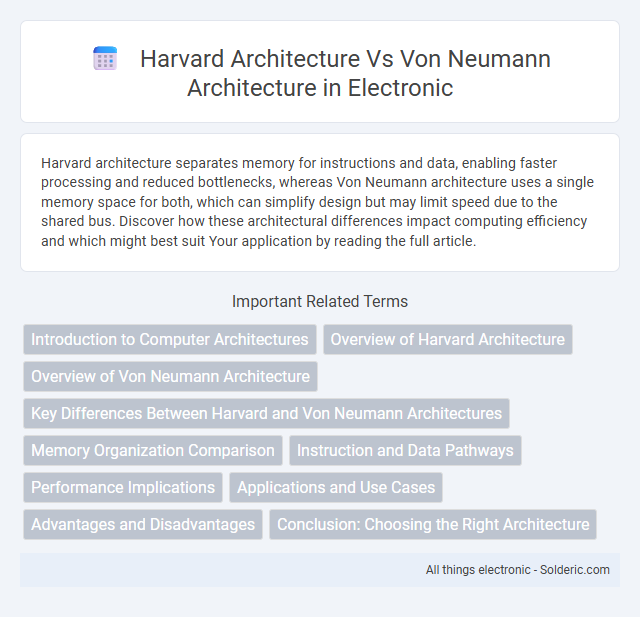Harvard architecture separates memory for instructions and data, enabling faster processing and reduced bottlenecks, whereas Von Neumann architecture uses a single memory space for both, which can simplify design but may limit speed due to the shared bus. Discover how these architectural differences impact computing efficiency and which might best suit Your application by reading the full article.
Comparison Table
| Feature | Harvard Architecture | Von Neumann Architecture |
|---|---|---|
| Memory Structure | Separate memory for instructions and data | Shared memory for instructions and data |
| Data and Instruction Buses | Separate buses for data and instructions | Single bus for data and instructions |
| Performance | Higher performance due to parallelism | Lower performance; bottleneck due to shared bus |
| Complexity | More complex hardware design | Simpler hardware design |
| Use Cases | Embedded systems, DSPs, microcontrollers | General-purpose computers |
| Instruction Fetch and Data Access | Simultaneous fetching allowed | Sequential access; instructions and data share bus |
| Cost | Generally more expensive due to separate memory | Cost-effective, fewer components |
Introduction to Computer Architectures
Harvard architecture separates memory storage and signal pathways for instructions and data, enabling simultaneous access and increased processing speed, while Von Neumann architecture uses a unified memory for both instructions and data, leading to potential bottlenecks known as the Von Neumann bottleneck. Harvard architecture is commonly utilized in digital signal processors where efficiency and speed are critical, whereas Von Neumann architecture underpins most general-purpose computers due to its simplicity and flexibility. Understanding these foundational computer architectures is essential for optimizing system performance in embedded systems, microcontrollers, and high-performance computing applications.
Overview of Harvard Architecture
Harvard architecture separates memory storage and signal pathways for instructions and data, allowing simultaneous access and improved processing speed. This design enhances performance in embedded systems and digital signal processors by reducing bottlenecks associated with data fetch. Your choice of architecture impacts efficiency, with Harvard architecture offering advantages in parallelism and predictable timing over Von Neumann systems.
Overview of Von Neumann Architecture
Von Neumann architecture features a single memory space for both instructions and data, enabling sequential processing through a shared bus system. This design simplifies hardware but can cause bottlenecks known as the Von Neumann bottleneck, limiting processing speed. Understanding this structure is crucial for optimizing Your system's performance in applications requiring rapid data and instruction access.
Key Differences Between Harvard and Von Neumann Architectures
Harvard architecture separates memory and pathways for instructions and data, enabling simultaneous access that enhances processing speed and efficiency, while Von Neumann architecture uses a single memory and bus for both instructions and data, leading to potential bottlenecks known as the Von Neumann bottleneck. Harvard architecture is typically favored in digital signal processing and embedded systems due to its parallelism, whereas Von Neumann is common in general-purpose computing for its simplicity and flexibility. Understanding these key differences helps you choose the appropriate architecture based on your system's performance and design requirements.
Memory Organization Comparison
Harvard architecture features separate memory spaces and buses for instructions and data, enabling simultaneous access that improves processing speed and efficiency. Von Neumann architecture uses a unified memory for both instructions and data, causing potential bottlenecks as the processor must fetch instructions and data sequentially. Your choice between these architectures impacts system performance, especially in applications demanding high-speed data handling or simplified design.
Instruction and Data Pathways
Harvard architecture uses separate pathways for instructions and data, allowing simultaneous access and increased speed in processing tasks. Von Neumann architecture employs a single shared bus for both instructions and data, which can create a bottleneck known as the Von Neumann bottleneck, slowing down performance. Your system's efficiency can be significantly influenced by choosing the architecture that matches your application's need for speed and complexity.
Performance Implications
Harvard architecture offers improved performance through separate memory pathways for instructions and data, enabling simultaneous access that reduces bottlenecks in processing. Von Neumann architecture, with a shared memory for instructions and data, can experience slower execution speeds due to the sequential fetch-decode-execute cycle and potential memory contention. Your system's performance benefits from Harvard architecture's ability to parallelize memory operations, particularly in applications demanding high-speed processing and reduced latency.
Applications and Use Cases
Harvard architecture is extensively used in embedded systems, digital signal processing, and microcontrollers due to its separate memory paths that enable faster instruction execution and data access. Von Neumann architecture remains the foundation for general-purpose computers, servers, and desktops because of its straightforward design and efficient use of memory for both instructions and data. Applications requiring high-speed real-time processing often prefer Harvard architecture, while software development environments and flexible computing tasks rely on Von Neumann systems.
Advantages and Disadvantages
Harvard architecture separates memory for instructions and data, allowing simultaneous access that boosts processing speed and efficiency, while its fixed memory paths can limit flexibility in complex programs. Von Neumann architecture uses a single memory space for both instructions and data, which simplifies hardware design and program modification but can cause bottlenecks due to sequential memory access. Understanding your system's performance needs can help you choose the architecture that balances speed and flexibility for optimal computing efficiency.
Conclusion: Choosing the Right Architecture
Selecting the appropriate architecture depends on the specific application requirements and performance priorities. Harvard architecture excels in embedded systems and digital signal processing due to its separate memory paths, enabling faster instruction and data access. Von Neumann architecture suits general-purpose computing with its simpler design and shared memory, offering flexibility and ease of programming.
Harvard architecture vs Von Neumann architecture Infographic

 solderic.com
solderic.com